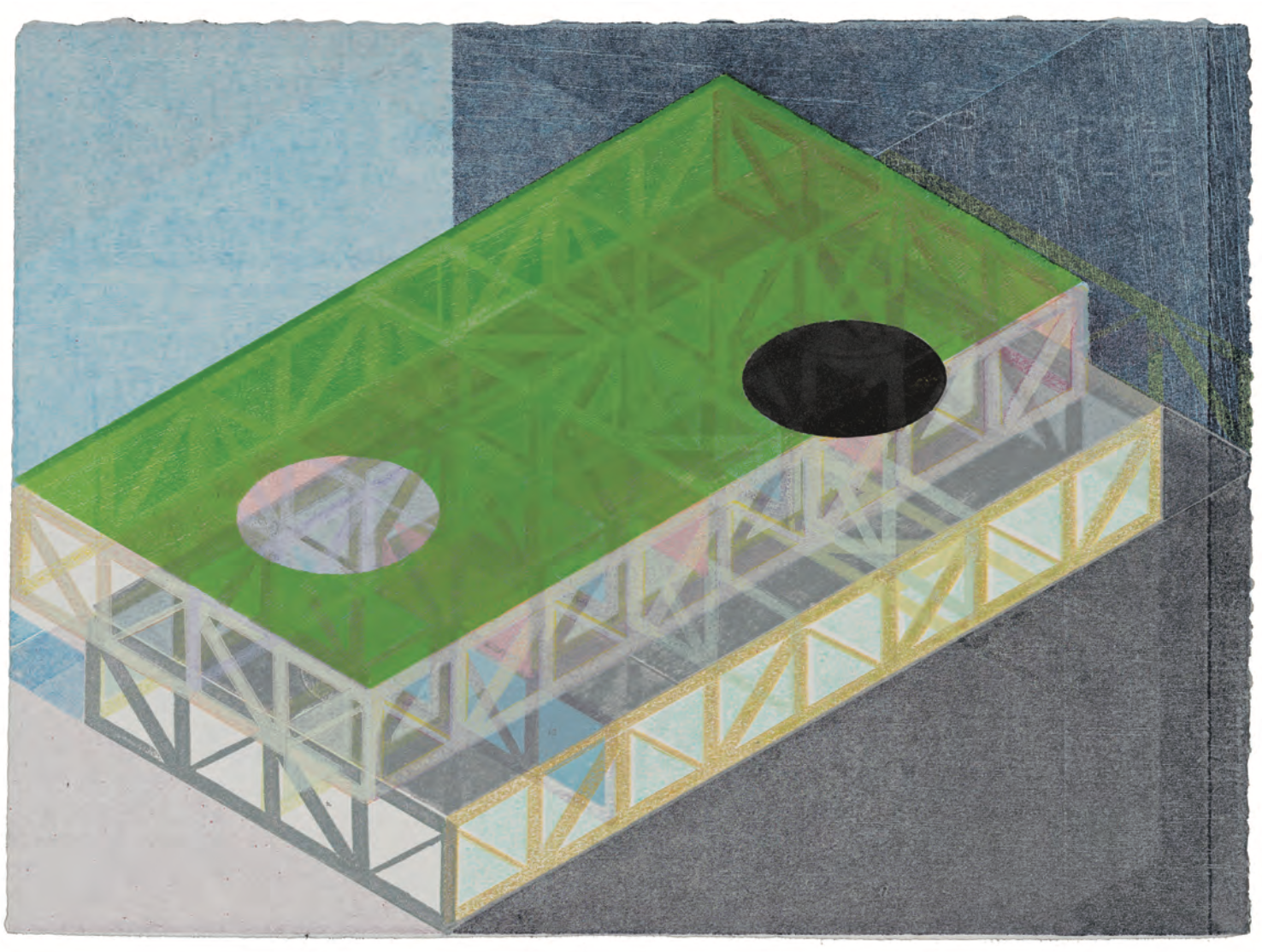Stages (iterate)
2018
2018




View HERE for full suite of images
Contact Kelly for printed availability
In the spring of 2016, I received an email from Stan Shellabarger inviting me to print with him at Spudnik Press. Stan would help me explore a printing project of my design in exchange for a selection from the resulting project. When the offer arrived, I was newly in the throes of attempting to balance work with parenthood. There was very little time and energy for a studio practice. I accepted the invitation.
In thinking about my approach to making a print, I decided to continue using the stage, a form I’ve been addressing in sculpture and installation for a decade now. At first, I thought of the stage as a platform implicitly carrying the possibility for performing narrative but quickly shifted to recognize the stage as a spatial object claiming agency over its own performativity. And in more recent years, I’ve been concerned with approaching affect and empathy in constructing the stage. I am ready to leave the stage behind but am compelled to do so by moving through it: dissecting, reorienting, transgressing, conflating, diffusing, disappearing.
I decided to print the image of a stage in relation to the way the provisional platform might be assembled in actual space, one scaffold at a time. I was interested in the idea of a compressed structure, a dimensional form rendered flat through sequential layers. To do so, I built a puzzle with a stage top in isometric perspective accompanied by four separate sized scaffolds in relief, each piece arranged in a specific direction within the matrix. The surrounding pieces allowed me to shift the position of the scaffold as well as the orientation of the stage. I placed the pieces and chose the color while Stan inked and registered the plate. Now and again, as I mulled over color or placement, Stan would print ghost runs or background plates that provided a ground which I was naturally driven to develop. Each scaffold, stage top, background and hole is at least one pass through the press.
After almost two years of working with Stan for 5-6 hours once every week, we brought the project to a close with 84 prints. It was an intense process of iteration in more than merely formal ways. The investigation of spatial optics and color was important, bu so were our human interactions, the affects of our everyday goings on. We would talk about our week, our politics, our families, our bodies, our work. So the project is also a testament to patience and heart. I mean this work is not only further evidence of Stan’s natural kinship with time, but also my own (re)learning of dedication. For me, this project became as much about moving through and beyond a form as about making a friend who helped me believe in my work again in a time of immense change.
Produced at Spudnkik Press
Presented at:
Julius Ceasar
Danny Floyd exhibition
Contact Kelly for printed availability
In the spring of 2016, I received an email from Stan Shellabarger inviting me to print with him at Spudnik Press. Stan would help me explore a printing project of my design in exchange for a selection from the resulting project. When the offer arrived, I was newly in the throes of attempting to balance work with parenthood. There was very little time and energy for a studio practice. I accepted the invitation.
In thinking about my approach to making a print, I decided to continue using the stage, a form I’ve been addressing in sculpture and installation for a decade now. At first, I thought of the stage as a platform implicitly carrying the possibility for performing narrative but quickly shifted to recognize the stage as a spatial object claiming agency over its own performativity. And in more recent years, I’ve been concerned with approaching affect and empathy in constructing the stage. I am ready to leave the stage behind but am compelled to do so by moving through it: dissecting, reorienting, transgressing, conflating, diffusing, disappearing.
I decided to print the image of a stage in relation to the way the provisional platform might be assembled in actual space, one scaffold at a time. I was interested in the idea of a compressed structure, a dimensional form rendered flat through sequential layers. To do so, I built a puzzle with a stage top in isometric perspective accompanied by four separate sized scaffolds in relief, each piece arranged in a specific direction within the matrix. The surrounding pieces allowed me to shift the position of the scaffold as well as the orientation of the stage. I placed the pieces and chose the color while Stan inked and registered the plate. Now and again, as I mulled over color or placement, Stan would print ghost runs or background plates that provided a ground which I was naturally driven to develop. Each scaffold, stage top, background and hole is at least one pass through the press.
After almost two years of working with Stan for 5-6 hours once every week, we brought the project to a close with 84 prints. It was an intense process of iteration in more than merely formal ways. The investigation of spatial optics and color was important, bu so were our human interactions, the affects of our everyday goings on. We would talk about our week, our politics, our families, our bodies, our work. So the project is also a testament to patience and heart. I mean this work is not only further evidence of Stan’s natural kinship with time, but also my own (re)learning of dedication. For me, this project became as much about moving through and beyond a form as about making a friend who helped me believe in my work again in a time of immense change.
Produced at Spudnkik Press
Presented at:
Julius Ceasar
Danny Floyd exhibition